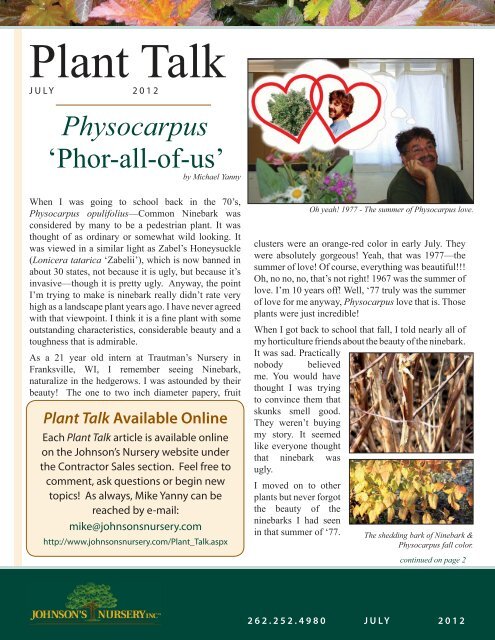Plant Talk - Johnson's Nursery
Plant Talk - Johnson's Nursery
Plant Talk - Johnson's Nursery
You also want an ePaper? Increase the reach of your titles
YUMPU automatically turns print PDFs into web optimized ePapers that Google loves.
<strong>Plant</strong> <strong>Talk</strong><br />
JULY 2012<br />
Physocarpus<br />
‘Phor-all-of-us’<br />
by Michael Yanny<br />
When I was going to school back in the 70’s,<br />
Physocarpus opulifolius—Common Ninebark was<br />
considered by many to be a pedestrian plant. It was<br />
thought of as ordinary or somewhat wild looking. It<br />
was viewed in a similar light as Zabel’s Honeysuckle<br />
(Lonicera tatarica ‘Zabelii’), which is now banned in<br />
about 30 states, not because it is ugly, but because it’s<br />
invasive—though it is pretty ugly. Anyway, the point<br />
I’m trying to make is ninebark really didn’t rate very<br />
high as a landscape plant years ago. I have never agreed<br />
with that viewpoint. I think it is a fine plant with some<br />
outstanding characteristics, considerable beauty and a<br />
toughness that is admirable.<br />
As a 21 year old intern at Trautman’s <strong>Nursery</strong> in<br />
Franksville, WI, I remember seeing Ninebark,<br />
naturalize in the hedgerows. I was astounded by their<br />
beauty! The one to two inch diameter papery, fruit<br />
<strong>Plant</strong> <strong>Talk</strong> Available Online<br />
Each <strong>Plant</strong> <strong>Talk</strong> article is available online<br />
on the Johnson’s <strong>Nursery</strong> website under<br />
the Contractor Sales section. Feel free to<br />
comment, ask questions or begin new<br />
topics! As always, Mike Yanny can be<br />
reached by e-mail:<br />
mike@johnsonsnursery.com<br />
http://www.johnsonsnursery.com/<strong>Plant</strong>_<strong>Talk</strong>.aspx<br />
clusters were an orange-red color in early July. They<br />
were absolutely gorgeous! Yeah, that was 1977—the<br />
summer of love! Of course, everything was beautiful!!!<br />
Oh, no no, no, that’s not right! 1967 was the summer of<br />
love. I’m 10 years off! Well, ‘77 truly was the summer<br />
of love for me anyway, Physocarpus love that is. Those<br />
plants were just incredible!<br />
When I got back to school that fall, I told nearly all of<br />
my horticulture friends about the beauty of the ninebark.<br />
It was sad. Practically<br />
nobody believed<br />
me. You would have<br />
thought I was trying<br />
to convince them that<br />
skunks smell good.<br />
They weren’t buying<br />
my story. It seemed<br />
like everyone thought<br />
that ninebark was<br />
ugly.<br />
I moved on to other<br />
plants but never forgot<br />
the beauty of the<br />
ninebarks I had seen<br />
in that summer of ‘77.<br />
Oh yeah! 1977 - The summer of Physocarpus love.<br />
The shedding bark of Ninebark &<br />
Physocarpus fall color.<br />
continued on page 2<br />
262.252.4980 JULY 2012
Physocarpus continued<br />
Ninebarks are large shrubs that grow to about 10’ tall<br />
and wide. They get their common name from the fact<br />
that the bark that sheds in reddish-brown strips. The<br />
birds like to use the bark strips for building nests in the<br />
spring. The myth is that these shrubs have nine layers<br />
of bark. Believe what you may.<br />
Common Ninebark has a vase shaped form that can<br />
resemble a Bridalwreath Spirea (Spiraea x vanhouttei),<br />
especially when its weeping branchlets are coated with<br />
clusters of creamy white flowers in mid-spring. In<br />
fall, I have seen individuals with foliage that turns a<br />
nice rusty, orange color. I’ve seen others turn maroon,<br />
though most are an unimpressive yellow.<br />
Physocarpus opulifoius is native to Wisconsin and<br />
can be found growing in some inhospitable places.<br />
Last summer, I saw it growing in a floating bog along<br />
with pitcher plants up near Portage, Wisconsin. This<br />
population had very pubescent leaves and pink fruit<br />
capsules. Years ago, I saw it growing out of cracks<br />
in rocks along the shores of Lake Superior in one of<br />
the toughest growing environments I could imagine.<br />
I’ve also seen them in old field situations in Southeast<br />
Wisconsin growing in heavy clay and thriving.<br />
The plant is tough.<br />
In the late 1990’s, the view of ninebarks as a pedestrian<br />
plant for landscaping changed. Monrovia <strong>Nursery</strong><br />
introduced Physocarpus opulifolius ‘Monlo’ PP11,211,<br />
Diabolo® Ninebark--the first purple leaved ninebark<br />
Fountain form of Summer Wine® in flower.<br />
Top: Diabolo®<br />
reaching mature<br />
size.<br />
Right: Physocarpus<br />
opulifolious in<br />
summer as fruit<br />
begins coloring.<br />
ever in the marketplace. They introduced the<br />
selection in 1999 from a plant found in 1968 at<br />
Kordes <strong>Nursery</strong> near Hamburg, Germany. It was<br />
found in a field of 120,000 seedlings. I guess<br />
there were others who really liked Physocarpus<br />
opulifolius, even back then!<br />
This shrub soon replaced the once popular Purple<br />
Leaf Sand Cherry, Prunus x cistena, as the most<br />
popular purple leafed, large shrub for midwestern<br />
gardens. It’s dark purple foliage sets off white<br />
flower clusters in late spring in such a way that it is<br />
almost irresistible to gardeners. In fall, the foliage<br />
turns a combination of red, purple and orange. It can<br />
be quite showy. Diabolo® has purple fruit capsules<br />
that fade to tan as they age. Diabolo® or ‘Diablo’<br />
as most people incorrectly say, is a large plant,<br />
getting to about 10’ tall and wide in 10 years from<br />
a cutting. The plant was so impressive in the early<br />
2000’s that it won the Pennsylvania Horticultural<br />
Society Gold Medal Award in 2002 and the Royal<br />
Horticultural Society Award of Garden Merit in the<br />
same year.<br />
continued on page 3<br />
www.johnsonsnursery.com Vol. 1 No. 6
Physocarpus continued<br />
The original Little Devil in David Zlesak’s yard &<br />
Little Devil flowers.<br />
Diabolo® is truly a breakthrough plant in the history of<br />
ninebark. It has lead to a series of other cultivars which<br />
were developed from some of the same purple foliage<br />
coloration genes. Among these newer cultivars are 3<br />
that we grow at Johnson’s <strong>Nursery</strong>—Physocarpus<br />
opulifolius ‘Center Glow’ PP16,894, Physocarpus<br />
opulifoius ‘Seward’ PP14,821, Summer Wine®<br />
Ninebark, and Physocarpus opulifolius ‘Donna May’<br />
PP22,634, Little Devil Ninebark. I like them all.<br />
‘Center Glow’ Ninebark is a hybrid plant that’s the result<br />
of a cross between Diabolo® and ‘Dart’s Gold’, a gold<br />
foliaged form, made by Harold Pellet at the Landscape<br />
<strong>Plant</strong> Development Center in Mound, Minnesota. This<br />
cultivar, introduced in 2006, has tints of red, orange<br />
and gold in the new foliage as it emerges. It’s quite<br />
striking. As the leaves age, they turn a reddish-purple<br />
that is a bit brighter than the black-purple color of<br />
mature Diabolo® foliage. Center Glow is a full scale<br />
ninebark that can get to 8-10’ tall and 6-8’ wide. It has a<br />
somewhat fountain-like form and a slightly tidier habit<br />
than Diabolo®. It’s flowers have pink buds that open to<br />
white followed by bright, red fruit clusters. Fall color<br />
is a mix of red, maroon, and orange.<br />
Summer Wine® is another outstanding plant that<br />
comes from the Diabolo® lineage. It is a cross between<br />
Diabolo® and Physocarpus op. ‘Nanus’. The cultivar<br />
‘Nanus’ contributes it’s somewhat smaller stature into<br />
Fruit colors (clockwise from<br />
upper left) Physocarpus<br />
opulifolious, Diabolo®, Center<br />
Glow, Little Devil, & Summer<br />
Wine®.<br />
Summer Wine® making it a 6-8’ by 6-8’ plant. It’s<br />
leaves are slightly smaller than Diabolo®. Summer<br />
Wine® has a more compact habit than Diabolo®, but<br />
retains the same foliage color characteristics. I really<br />
like the mature Bridalwreath-like form of Summer<br />
Wine® (See picture on previous page).<br />
Little Devil Ninebark is a brand new, compact<br />
selection from Bailey Nurseries First Editions®<br />
program. Dr. David Zlesak, a horticulture professor<br />
at the University of Wisconsin—River Falls is the man<br />
who did the breeding work. Little Devil, like Summer<br />
Wine®, has Diabolo® and Physocarpus op. ‘Nanus’ in<br />
its parentage. It is the smallest in stature of the purpleleafed<br />
ninebarks that we carry. It will grow to 3-5’ tall<br />
by 3-5’ wide, forming a round, mound as it ages. The<br />
plant has little leaves, about half the size of those of<br />
Center Glow or Diabolo®. The foliage is reddish–<br />
purple but is not as dark as the other purple ninebarks.<br />
continued on page 4<br />
262.252.4980 JULY 2012
Physocarpus continued<br />
The small leaves give it a beautiful fine textured look.<br />
The flower clusters, which are described as button-like<br />
in Bailey’s catalog, make the plant downright cute—a<br />
cute little devil! I love the name! Little Devil’s cultivar<br />
name is ‘Donna May’, which refers to David Zlesak’s<br />
mother. Her favorite color is purple. She can certainly<br />
be proud of her son for developing such a fine plant.<br />
Ninebarks are relatively disease free except for<br />
some powdery mildew organisms that have been<br />
increasingly infecting them in our area. Podosphaera<br />
aphanis var. physocarpi (syn. Sphaerotheca aphanis<br />
var. physocarpi), specific only to Physocarpus, seems<br />
to be the worst and the generalist powdery mildews<br />
Phyllactinia guttata and Podosphaera macularis (syn.<br />
Sphaerotheca humuli and S. macularis) have been<br />
problematic as well. The mildews will cover portions<br />
of the plants with a coating of white that looks like<br />
flocking used on Christmas trees. It will sometimes<br />
cause witches brooming on the plants as well. My<br />
recommendation for control, if you see this disease<br />
is to cut off the infected areas and dispose of it away<br />
from your ninebark plants. I noticed on a planting<br />
that we have at the nursery that the new infections<br />
were occurring around the old witches brooms<br />
which had not been removed. There are differing<br />
susceptibilities to the mildews by the various<br />
cultivars. Summer Wine® and Little Devil have<br />
good resistance while Diabolo®, Center Glow, and<br />
the straight species are susceptible.<br />
When planting Ninebarks it is best to site them in<br />
full sun with good air movement to avoid mildew<br />
problems. Renewal pruning is the best way to<br />
maintain them. Remove a third or less of the oldest<br />
canes each spring before growth commences.<br />
Ninebarks can also be cut to the ground each spring<br />
if you desire. This allows you to have all fresh lush<br />
wood each year. It is a way to control size on the<br />
larger growing forms.<br />
Whichever way you want to grow your ninebark,<br />
if you are like me, you’ll find them to be excellent<br />
landscape plants. I’m hoping you’ll fall for them<br />
just like I did back in ‘77. Make the summer of<br />
2012 be your summer of Physocarpus love!<br />
Ninebark leaf size (left to right): Phy. opulifolious ‘Nanus’, Little Devil, Summer Wine®, & Diabolo®.<br />
www.johnsonsnursery.com Vol. 1 No. 6



